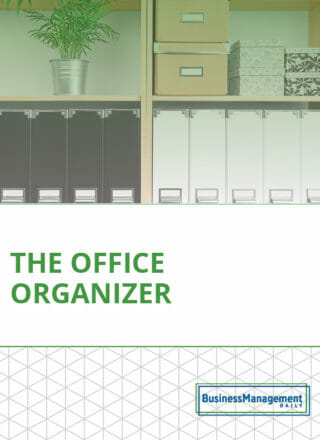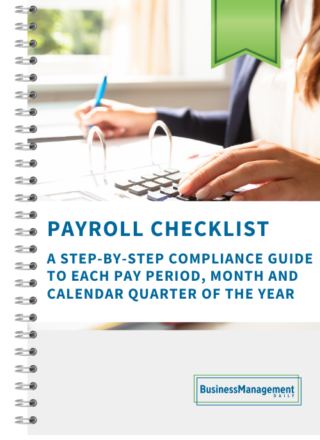Steps for Standard Operating Procedure (SOP) development
Most of the activities necessary to keep your business running can be broken down into specific tasks and business processes. Each employee contributes to the success of the organization by completing their assigned tasks each day. So why don’t you have the processes for these tasks written down?
Developing standard operating procedure documentation can help standardize your business processes to ensure that they are being completed in the most effective and efficient manner possible. Documenting these processes in a step-by-step format also gives employees something to follow if the person that normally completes the task is out sick or leaves the company.
If you’re ready to work on documenting your processes and developing standard operating procedures (SOP), here’s what you need to know.
What Needs to Be Included in an SOP?
A standard operating procedure (SOP) is a document containing step-by-step instructions on how to perform a specific process. These are typically technical, repetitive tasks that need to be performed frequently or hold significance. They’re meant to standardize business processes within an organization so that everyone is completing the task in a consistent and effective manner.
An effective SOP will be detailed and easy-to-follow. Include specific instructions on how to complete a task including what to click or select in computer systems at each step. Someone who has never done the task before should be able to pick up the SOP document and follow the instructions to work through it. It should also be detailed enough that there is no room for variation. If your steps are too vague, people will develop their own ways of following them rather than completing the intended standard operating procedures.
How to Develop SOPS
While the end result can look like a fairly simple document, the process of developing and writing SOPs can be fairly time intensive. Follow these steps to make the process seamless and effective.
1. Determine the scope of your SOP
Set the basic scope and parameters of the SOP that you plan to create. Often when starting the SOP development process, you will realize that some tasks or actions that you are hoping to create standard operating procedures for have multiple processes. Decide whether you will combine these processes into one SOP, or whether you will create multiple SOPs.
If your company is just starting to dive into SOPs, the planning phase will likely consist of creating lists of standard operating procedures that you wish to document prior to diving into creating a specific SOP. Note that not all processes need defined SOPs. Some processes have multiple efficient approaches or are subject to frequent variance or change. In these cases, setting a defined standard operating procedure may not be practical or effective.
Also, consider the intended audience of the standard operating procedure. Who will use the SOP? How much existing knowledge and experience with the process and the relevant tools will they have?
Try to identify the primary goals of the SOP. Are you looking to improve efficiency? Are safety or regulatory concerns present if employees deviate from this standard operating procedure and take shortcuts or do tasks in a different manner? Is the SOP mostly for new employees or fill-ins to use as a frame of reference for completing tasks that are new to them? SOP documentation can fulfill a number of purposes, but identifying your main goal will help you shape the development process and use the correct tone in your writing.
2. Decide Who Will Be Involved in the Process
Figure out who you will work with to develop the SOP in question. Consider key stakeholders such as managers, department leads, relevant employees, and subject matter experts.
Gathering input from the people who actually complete the task on a regular basis and potentially observing their process can be very helpful. Set up interviews to ask relevant employees about how they do their work and ask them to walk you through their current procedures.
Employees may not all follow the exact same procedures. That is okay. Observe several employees if possible and note how each person describes and completes the process. Then, speak with management to determine which version is best and should be used as the basis for a standard operating procedure.
Note that best can mean a few things. Ideally, the method of performing a task that is made into the SOP will be the most efficient process. As inefficiency hurts the business’ bottom line. However, it’s equally important to take accuracy, quality control, safety, and regulatory compliance into consideration.
If you have someone that does the design for your internal documents, you may want to loop them in now as well, particularly if you will be requesting visual elements for your standard operating procedure documentation.
3. Choose Your SOP Template or Format
It is best to keep a consistent format for documentation across all of your company’s standard operating procedures. If you have existing SOPs, find the template used previously or use an existing SOP as a formatting reference.
If you are writing your organization’s first SOP, you’ll need to choose a format. You can find formats online, design your own, or utilize SOP software. Some SOPs are straightforward step-by-step lists, while others incorporate visuals or are presented in a flowchart format. Pick a format that fits your organization’s internal branding and that can be easily replicated.
4. Gather Information
You’ll want to speak with team members that currently perform this task or workflow process to understand what steps they follow. Sometimes different people have different ways of doing things, so it’s often best to speak with several team members to understand each of their methodologies.
However, before conducting thorough interviews, it is a good idea to ask department leaders and staff if they have existing documentation of their business processes. Sometimes a well-organized department, employee, or trainer will have already created work instructions for specific tasks to help new employees. If this is the case you are in luck — you won’t have to fully start from scratch when writing your SOP.
You may also want to gather any data available. If your company measures productivity, output, accuracy, or other performance indicators, review those as well. Depending on your industry and the task involved you may also need to gather legal or regulatory information. If you were going to create an SOP based on the process for scanning in a new patient file for a healthcare company, you would need to gather information on HIPAA and how to handle and store sensitive patient information securely.
5. Write Your First Draft
Now it’s time to begin writing. While you’ve spent time interviewing people that are knowledgeable on the process, try to write your SOP with a less knowledgeable audience in mind. Do not assume that the reader will already know how to complete the process that you are documenting.
Gather your notes from the information gathering period and outline your SOP document. When writing SOPs, it’s usually easiest to start by writing out all of the steps in the process hierarchy, and then build out each step.
There are a couple of other elements that you may want to consider including in your SOP such as:
-
The Scope of the SOP. As discussed in step 1, understanding the scope and purpose of an SOP is important. It’s also helpful for the reader, particularly if the standardized operating procedure was put in place due to safety or regulatory concerns. They should understand the why in addition to the how.
-
Intended Audience. Add in a brief description of the intended audience. This can simply be a job title or department. This helps employees identify if they’ve found the right SOP. Your company may end up having multiple SOPs that are similar in nature but are intended for different departments and have somewhat varied processes.
-
Relevant Contacts. Consider adding in the contact that is in charge of managing and updating the SOP in case someone using it notices an issue. You can also include the manager in charge of overseeing the task as a contact point for questions about following the SOP or completing the task itself. An IT contact may also be included for issues arising with a computer system mentioned in the SOP.
-
Glossary. Adding a glossary at the end can help bridge the gap between knowledgeable and new employees utilizing the SOP documentation. List industry terms and acronyms that they may not be familiar with in the glossary.
6. Have Your Draft Reviewed
Once you feel good about your draft, have it reviewed. There may be multiple types of reviews that your draft needs to undergo. Someone should review it for spelling, grammar, formatting, and clarity.
You’ll also want someone to test the SOP and try to complete the process as described. Having two people try is even better; one who does the task regularly and one who has never done it before. See if they get stuck at any point in the process.
Your company’s safety officer, management team, or corporate counsel may also review the SOP if there are extenuating circumstances like safety or regulatory requirements related to the task being performed.
7. Make Any Necessary Edits
Incorporate the feedback that you received and make revisions to your SOP document. This may simply consist of reviewing suggested spelling and grammar edits on a shared document. However, if there are knowledge gaps or unclear instructions at any of the listed steps, you may need to conduct additional research or re-interview one of your collaborators or subject matter experts.
8. Decide How to Store or Distribute the SOP
You’ve spent all this time creating a new SOP, so now it’s time to share it with the rest of the staff. An SOP is only useful if it is easily accessible to those meant to follow it. While you can distribute paper copies, it’s usually best to store SOPs electronically. They can go in a Google or Microsoft Teams folder, or you can use an SOP software system to store them.
9. Update Your SOP As-Needed
The standard operating procedure document that you created will need to be reviewed and updated as processes change. Ideally, if a process changes, the employee or department lead will alert you that the SOP needs to be updated. However, this might not happen. It’s a good idea to schedule regular reviews of all of your company’s SOPs.
Many standard operating procedures detail the step-by-step process of completing technical tasks in one of the systems used by your organization. Be sure to test these SOPs and go through the steps at regular intervals, as updates to the user interface of your company’s chosen custom relations management software (CRM), payroll software, or even new Windows updates can result in changes to the specific procedures that need to be followed to complete a task.
Now you will have your completed standard operating procedure. Most companies have a large number of SOPs that grow over time, so be prepared to start the process over and create more. Developing and writing SOPs should get easier with practice.



